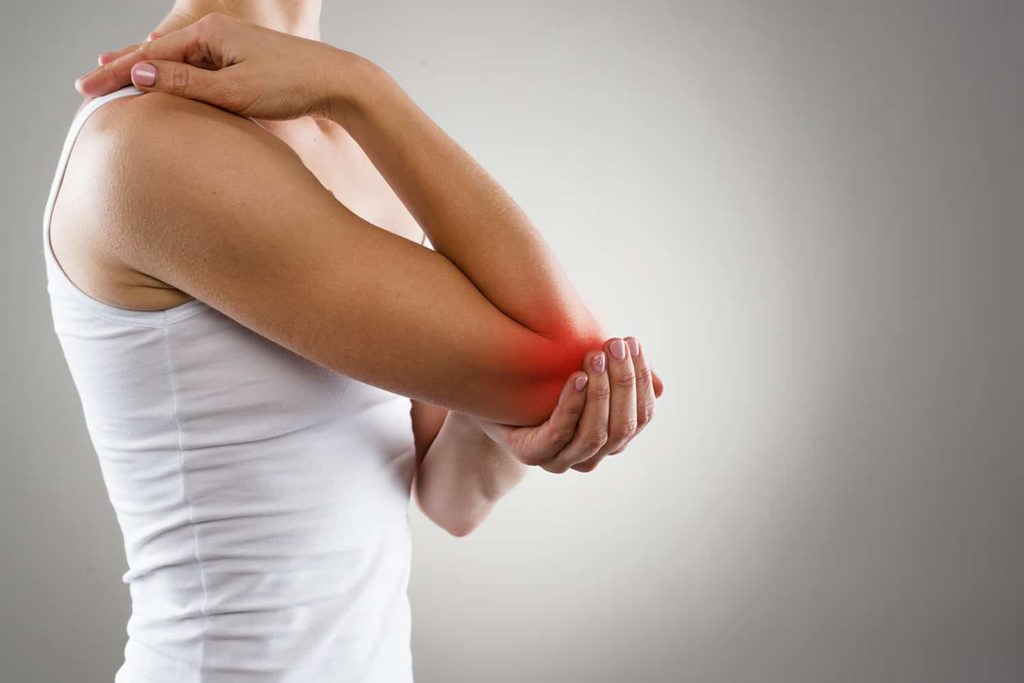A golfer’s elbow is a very common condition – not just for athletes. It can be caused by heavy repetitive movement or desk work. A golfer’s elbow treatment mainly focuses on rehabilitation. Check out what physiotherapy has to offer in these cases, besides rest, compresses and exercise.
Inflammation of the medial epicondyle of the humerus, commonly called golfer’s elbow, is forearm flexor attachment enthesopathy. This is usually due to damage to the reversible circular or radial flexor wrist muscle attachments, often caused by repetitive repetitive actions, manual work, or heavy lifting.

Golfer’s Elbow – Symptoms
The main symptom of a golfer’s elbow is severe pain on the inside, medial side of the elbow, sometimes radiating to the forearm, wrist and even the small and ring fingers. Soreness occurs when grabbing and carrying things, throwing a ball, opening a door with a handle, or shaking hands. Initially, the pain is mild and is not associated with other restrictions on mobility or strength, but only intensifies as the forearm is guided and resisted.
For the more advanced stage of the golfer’s elbow, symptoms include soreness of the elbow, stiffness and weakness of the arm, wrist, and fingers. Some people complain of numbness or tingling in the forearm – usually associated with pain in the fingers.
Golfer’s Elbow – Challenge
As with many injuries, athletes are particularly vulnerable. The golfer’s elbow applies to people practicing disciplines such as handball, of course, golf, archery, rock climbing, weightlifting (especially with technical errors), javelin throwing, as well as rocket sports: badminton, tennis, squash.
However, this injury can occur in people who work a lot in the garden, wash the floor, carpenters, painters, dentists, as well as office workers who spend a lot of time at the computer. The injury is usually caused by repeated flexion and extension of the elbow, which means prolonged muscle overload and micro-trauma to the tissue.
Other possible causes – although less common – are fibrosis, calcification, fractures, growth in the affected area, or cancer.
Golfer’s Elbow – Treatment
How to treat a golfer’s elbow? In the case of minor injuries, this may be enough to rest and cool the injury (ice or cooling gels). However, if these methods do not give any effect, we have a fever or a problem with bending the elbow, we should definitely consult a doctor. Diagnosis can be confirmed by ultrasound, X-ray, or magnetic resonance imaging, but usually the specialist needs to interview the patient and palpate.
For injuries such as a golfer’s elbow, treatment begins with pain relievers and anti-inflammatory drugs. and cold compresses. They are supported by limiting movement and unloading the limb, often with a brace.
If a golfer’s elbow is diagnosed, then physical therapy is one of the key elements of treatment. What can this offer us? Usually, rehabilitation includes isometric exercises, and at a later stage, more complex resistance exercises. In addition, a number of procedures are used, including:
- TECAR therapy,
- laser therapy,
- shock wave,
- ultrasound,
- iontophoresis,
- cryotherapy,
- magnetic therapy,
- transverse and functional massage,
- kinesiotaping.
We decided to describe in more detail selected ones.
TECAR Therapy
TECAR Therapy takes advantage of the positive effect of high frequency radio waves on diseased cells. By providing a large dose of energy to tissues, the treatment improves blood circulation, drainage and oxygenates tissues, thereby accelerating regeneration.
In the case of a golfer’s elbow, both capacitive and resistive modes of operation are used during rehabilitation with the TECAR therapy device, which gives the best results. Due to the great similarity of both injuries and treatments, we recommend our materials showing tennis elbow treatment with TECAR therapy.
Shockwave therapy
Shockwave therapy is one of the most effective treatments for many injuries, with a wide range of applications. Physiotherapy of a golfer’s elbow with the Rosetta ESWT provides a quick, but most importantly, long-term pain relief. How? Shock wave therapy stimulates microcirculation and, with it, cellular metabolism. Thus, the damaged tissue regenerates faster and the pain ceases to affect the patient.
High Energy Laser Therapy
Laser therapy complements the shock wave perfectly. The iLUX high-energy laser helps to effectively reduce muscle tension and quickly and efficiently generate trigger points to reduce pain, better blood supply to tissues and regenerate cells faster.
Together, we also recommend watching this procedure with a similar example in the article: Tennis Elbow – Description of the Illness and Treatment with a High Energy Laser.
Golfer’s Elbow – Surgical Treatment
And how to treat a golfer’s elbow when physical therapy hasn’t improved? This assessment is usually done after 2-3 months. If no results are found, surgery may be required. Then it may take another 4 months to recover.
To reduce the risk of a golfer’s elbow, you should do appropriate exercises that will strengthen your forearm muscles, warm up before training, and provide a proper working environment at the table.
